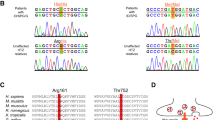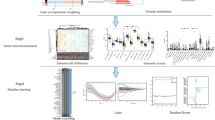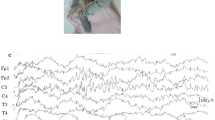Abstract
We report about the partial de novo loss of GLRB and GRIA2 in an individual with intellectual disability (ID). No additional mutations were found in either gene. GLRB itself does not seem to be a good candidate as it causes autosomal recessive hyperekplexia and no symptoms were found in the patient. Mutations of GRIA2 have not been described as cause of ID to date. Nonetheless, it is a very attractive candidate because it encodes a subunit of a glutamate receptor, which is highly expressed in postsynaptic structures and has an important role in signal transduction across synapses. Although we were able to isolate a fragment of a fusion transcript of both genes from the patient's blood, we were not able to isolate a transcript with an open reading frame throughout the entire length. The reading frame could be restored by differential splicing, which might take place in brain tissue but not in blood. We assume that either haploinsufficiency of GRIA2 or a GLRB/GRIA2 fusion gene leading to a protein with dominant-negative properties is causing the phenotype of the patient.
Similar content being viewed by others
Log in or create a free account to read this content
Gain free access to this article, as well as selected content from this journal and more on nature.com
or
References
Endele S, Rosenberger G, Geider K et al. Mutations in GRIN2A and GRIN2B encoding regulatory subunits of NMDA receptors cause variable neurodevelopmental phenotypes. Nat Genet 2010; 42: 1021–1026.
Wu Y, Arai AC, Rumbaugh G et al. Mutations in ionotropic AMPA receptor 3 alter channel properties and are associated with moderate cognitive impairment in humans. Proc Natl Acad Sci USA 2007; 104: 18163–18168.
Bonnet C, Leheup B, Beri M, Philippe C, Gregoire MJ, Jonveaux P : Aberrant GRIA3 transcripts with multi-exon duplications in a family with X-linked mental retardation. Am J Med Genet A 2009; 149A: 1280–1289.
Motazacker MM, Rost BR, Hucho T et al. A defect in the ionotropic glutamate receptor 6 gene (GRIK2) is associated with autosomal recessive mental retardation. Am J Hum Genet 2007; 81: 792–798.
Su AI, Wiltshire T, Batalov S et al. A gene atlas of the mouse and human protein-encoding transcriptomes. Proc Natl Acad Sci USA 2004; 101: 6062–6067.
Krugers HJ, Hoogenraad CC, Groc L : Stress hormones and AMPA receptor trafficking in synaptic plasticity and memory. Nat Rev Neurosci 2010; 11: 675–681.
Mead AN, Stephens DN : Involvement of AMPA receptor GluR2 subunits in stimulus-reward learning: evidence from glutamate receptor gria2 knock-out mice. J Neurosci 2003; 23: 9500–9507.
Al-Owain M, Colak D, Al-Bakheet A et al. Novel mutation in GLRB in a large family with hereditary hyperekplexia. Clin Genet 2012; 81: 479–484.
Rees MI, Lewis TM, Kwok JB et al. Hyperekplexia associated with compound heterozygote mutations in the beta-subunit of the human inhibitory glycine receptor (GLRB). Hum Mol Genet 2002; 11: 853–860.
Mehmood T, Schneider A, Sibille J et al. Transcriptome profile reveals AMPA receptor dysfunction in the hippocampus of the Rsk2-knockout mice, an animal model of Coffin-Lowry syndrome. Hum Genet 2011; 129: 255–269.
Tzschach A, Menzel C, Erdogan F et al. Characterization of an interstitial 4q32 deletion in a patient with mental retardation and a complex chromosome rearrangement. Am J Med Genet A 2010; 152A: 1008–1012.
Feenstra I, Fang J, Koolen DA et al. European Cytogeneticists Association Register of Unbalanced Chromosome Aberrations (ECARUCA); an online database for rare chromosome abnormalities. Eur J Med Genet 2006; 49: 279–291.
Matsuzaki H, Wang PH, Hu J, Rava R, Fu GK : High resolution discovery and confirmation of copy number variants in 90 Yoruba Nigerians. Genome Biol 2009; 10: R125.
Redon R, Ishikawa S, Fitch KR et al. Global variation in copy number in the human genome. Nature 2006; 444: 444–454.
Hamdan FF, Gauthier J, Araki Y et al. Excess of de novo deleterious mutations in genes associated with glutamatergic systems in nonsyndromic intellectual disability. Am J Hum Genet 2011; 88: 306–316.
Nothwang HG, Kim HG, Aoki J et al. Functional hemizygosity of PAFAH1B3 due to a PAFAH1B3-CLK2 fusion gene in a female with mental retardation, ataxia and atrophy of the brain. Hum Mol Genet 2001; 10: 797–806.
Acknowledgements
The work was supported by the Bundesministerium für Bildung und Forschung (BMBF) network grant MR-NET 01GS08166.
Author information
Authors and Affiliations
Corresponding author
Ethics declarations
Competing interests
The authors declare no conflict of interest.
Additional information
Supplementary Information accompanies the paper on European Journal of Human Genetics website
Rights and permissions
About this article
Cite this article
Hackmann, K., Matko, S., Gerlach, EM. et al. Partial deletion of GLRB and GRIA2 in a patient with intellectual disability. Eur J Hum Genet 21, 112–114 (2013). https://doi.org/10.1038/ejhg.2012.97
Received:
Revised:
Accepted:
Published:
Issue date:
DOI: https://doi.org/10.1038/ejhg.2012.97
Keywords
This article is cited by
-
SRF depletion in early life contributes to social interaction deficits in the adulthood
Cellular and Molecular Life Sciences (2022)
-
RAB39B-mediated trafficking of the GluA2-AMPAR subunit controls dendritic spine maturation and intellectual disability-related behaviour
Molecular Psychiatry (2021)
-
AMPA receptor GluA2 subunit defects are a cause of neurodevelopmental disorders
Nature Communications (2019)



